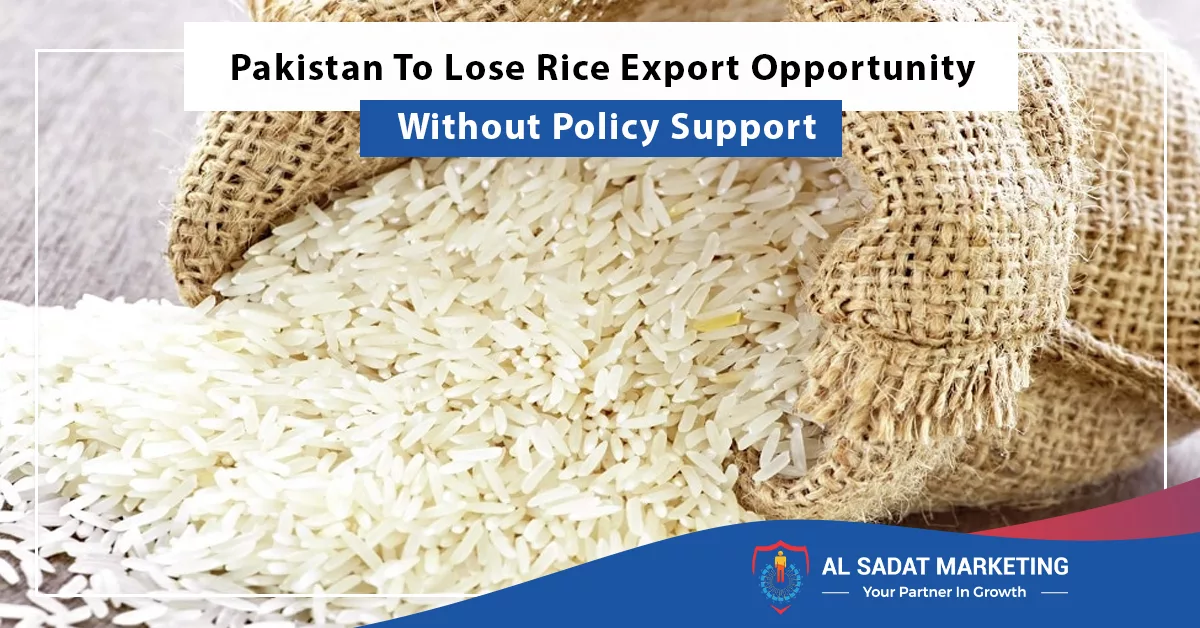In the first two months of FY24, Pakistan’s rice exports fell 17.3 percent to $233 million from $283 million in FY23.
While basmati rice shipments rose by 8.2%, other categories (IRRI-6, IRRI-9, Broken, etc.) that account for 80% of all rice exports decreased by 28%.
There are bigger issues preventing the nation from competing to its full potential in the $365 billion global rice market, despite the fact that the decline can be primarily attributed to lower inventories of other categories of rice and the fact that the harvest season of IRRI varieties has yet to start next month.
Exports of rice fell by 14.47 percent in FY23, from $2.5 billion in FY22 to $2.1 billion, with Basmati and other categories seeing declines of 6.3 and 17.5 percent, respectively.
Read More: Why Your Roasted Peanuts Might Cost More This Winter?
The fall was mostly anticipated because the nation’s production was curtailed by disastrous floods by 21% the previous year, but this year, expectations are high because the output is anticipated to jump to 9 million tons along with a number of other factors.
India, the largest exporter of rice in the world, first outlawed the export of non-basmati varieties outright, levied a 20 percent levy on the export of parboiled rice, and set a higher floor price for the basmati kinds of $1,200 per metric ton.
The rise in global rice prices to their highest level in 15 years has given Pakistan a rare opportunity to grow its market share and exports, but are we doing enough to seize this chance?
According to an exporter we spoke with, the required cargo insurance can cost up to $2 million when dealing directly with buyers in larger markets like the United States, making it accessible for just a select few in the market. Most exporters attempt to trade with resellers in a hub like the United Arab Emirates (UAE) in order to avoid that, although doing so not only cuts margins but also creates extra issues.
Agritech founder and marketing director at Hathor Trading LLC Nabeel Yusuf described to ProPakistani how he lost three clients as a result of encountering regulatory obstacles during the clearing of export shipments.
Yusuf told ProPakistani, “We entered the rice trade to finally uplift the farmers after learning that offering a complete value chain is the only way forward in adequately serving the farming community.
Read More: Over 90,000 Pakistanis Left the Country in August for Jobs
According to FATF criteria, some obstacles may have made sense from a regulatory standpoint, he continued, but there was no business justification for requests like credit verification. He argued that since Pakistan and India were the only countries in the world to produce rice of this caliber, why couldn’t the government waive or relax some regulations during the length of the Indian ban?
In the recent years, Pakistan had an overabundance of tomatoes and potatoes, which farmers were forced to either throw in streams or plow into fields because the market price could not even cover the cost of harvesting. He claimed that reaching out to regional and global buyers and offering these products could have been the answer.
Due to cheaper production costs and just having a superior value chain, India has been outbidding and undercutting Pakistan in the global rice market for decades. Prior to the complete prohibition, India had a nearly 20% levy on the export of non-basmati rice, but its prices were still lower than those of Pakistani rice on the global market.
Fundamentally, Pakistan lacks flexible policymaking that can quickly adapt to changing market changes. The system has too many moving components, so by the time any action, or more precisely, “reaction,” is done, the impact is frequently negligible.
There should have been steps taken to encourage more people to participate in rice exports given the current Indian prohibition and rising global prices.
In order to complete the commercial and regulatory requirements of export business processes and transfer the Basmati rice from the exporter’s warehouse to the shipping vessel en route to the port of discharge in the destination country, it typically takes stakeholders 16 business days and the same number of documents, according to a 2020 Report by the Trade Development Authority of Pakistan (TDAP) on the rice sector.
Transporting the goods to the port takes almost three days, loading it onto the ship takes two days, export-related paperwork preparation, cargo insurance, and phyto certification each take a full day, and setting up an empty container takes close to ten hours.
Read More: Heavy Taxes Shut Down Half Of Cotton Ginning Industry
According to our conversations with exporters through legacy exporters, who allegedly receive the benefit of expedited processes and are aware of these shortcuts, this time is currently more realistically estimated to be around 20-21. However, this leaves bottlenecks in the industry that deter new players from entering and bringing innovative approaches to the market.
One further thing to keep in mind is that these are the standards for current exporters, whereas the entry threshold is substantially higher for new entrants.
Since lowering the cost of production is a long-term question with an answer that depends on overhauling the entire agriculture sector, we need new minds with innovative approaches to branding and marketing our product if we want to compete with India. However, putting more emphasis on enabling better branding and marketing is at least a reasonable request.
According to Amit Kumar, a rice dealer from Karachi speaking to ProPakistani, “If someone wants to register a new company, he first has to go through Rice Exporter Association Pakistan (REAP), then chambers of commerce, and getting membership at both places takes approximately 7-10 days.”
In the case of particular procedures, such as having packing material, he continued, some exporters with capital can buy in bulk for quick operations, but the majority of the time, delays are felt by all exporters. As a result of the drop in dollar exchange rates, he also said that one of the issues is that the export market has all but collapsed and stopped existing.
Kumar added that exporters have started purchasing Indian rice and repackaging it as Pakistani brands because Pakistani rice prices have been so high in recent years. In order to make long-term decisions, he continued, it is also necessary to have greater data availability about the data on how much we have in terms of critical commodities and how much we can export.
While we must look past the Indian ban because it is a one-time thing that may be changed by mid-October, we are neglecting to take advantage of this chance. India, on the other hand, is reportedly charging about $100 more per ton when giving ban exceptions for government-to-government contracts since they are adept at making the most of any circumstance.
The good news is that Mexico traveled all the way to Pakistan, conducted numerous tests and surveys, and ultimately determined to permit rice imports from Pakistan, which had been prohibited since 2013. In light of these developments, REAP expressed confidence that Pakistan’s rice exports will surpass the $3 billion mark this year in a recent announcement. Russian markets have also opened to Pakistan.
It was also mentioned that the association had provided the government with a blueprint four years earlier to expand rice exports to $5 billion, but that the implementation was still pending. It also emphasized the necessity of setting up policy boards to monitor commodity supply and demand in order to decide whether to export commodities.
The Pakistan Single Window (PSW) system, which the government recently launched, brought banks, customs, exporters, and clearing authorities together in one location, although it has only a limited impact on streamlining overall procedures and lowering obstacles to entry. While Mexico, Russia, and some other markets are showing promising signs, it is unclear what part we are playing in making that happen.
There is a need to offer a genuine one-window operation so that exporters, both new and established, can contribute new thoughts and vigor. The moment had come to lower these barriers for exporters so that they might benefit the most from this opportunity, but neither short-term nor long-term policymaking has been done in this area.
You can also invest in other famous and most in demand housing societies, such as , Blue World City, Rudn Enclave, 7 Wonders City Peshawar, Taj Residencia, Kingdom Valley, New Metro City Gujar Khan, Forest Town Rawalpindi, University Town Rawalpindi, ICHS Town, Park View City Islamabad, Multi Gardens B17 Islamabad and Nova City Islamabad.
Al Sadat Marketing please contact 0331 1110005 or visit https://alsadatmarketing.com/
Few more real estate housing schemes which are trending now a days in Islamabad by including: Faisal Town Phase 2, Prism Town Gujar Khan, New City Paradise, Eighteen Islamabad, 7 Wonders City Islamabad, Capital Smart City, Silver City Islamabad, The Life Residencia, Faisal Town Islamabad, Islamabad Golf City, Islamabad Model Town and Marble Arch Enclave.
Al Sadat Marketing is an emerging Real Estate Agency headquartered in Islamabad, Pakistan. With over 10+ Years of experience, Al Sadat Marketing is providing its services and dealing all trending housing societies projects in different cities of Pakistan. Islamabad Projects, Rawalpindi Projects, Gujar Khan Projects, Burhan Projects, and Peshawar Projects etc.
Book Your Plot Now: +92 331 111 0005










